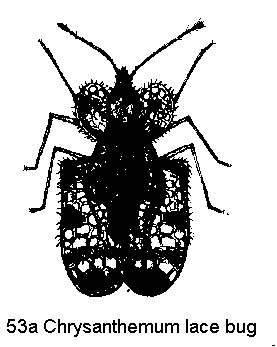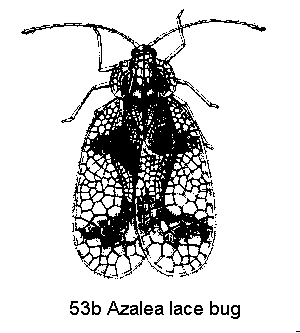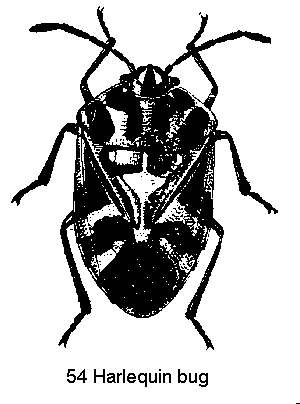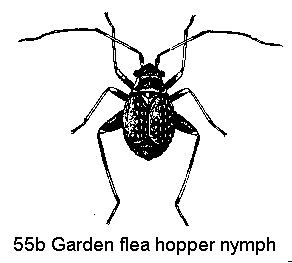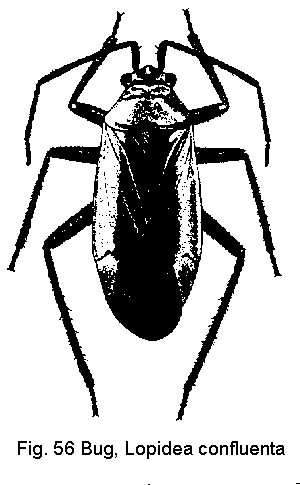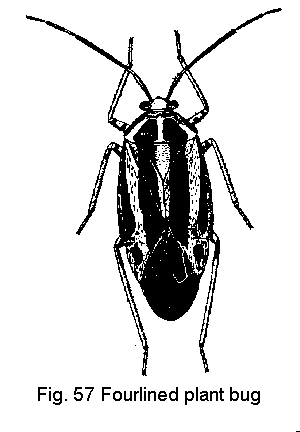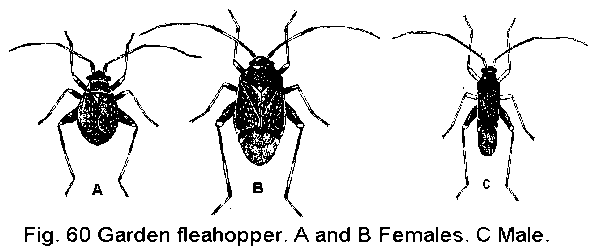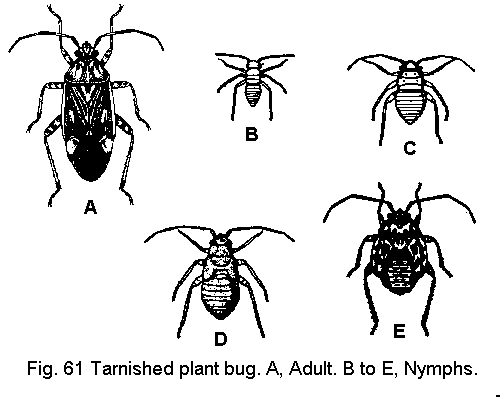Key to the Most Common Bugs Found on Flowers and Foliage
- Thorax with lateral extensions divided into numerous small cells (Figure 53A and Figure 53B) - GO TO 2
Thorax without lateral extensions and not divided into numerous small cells - GO TO 3 -
Lateral extensions of thorax with spines (Figure 53A) (Immatures with each segment of abdomen with a multiple-tipped spine on each side); feeds on chrysanthemum, aster, scabiosa, and goldenrod - CHRYSANTHEMUM LACE BUG
Lateral extensions of thorax without spines (Figure 53B) (Immatures with each segment of abdomen with a slender, simple spine on each side, Figure 53C); feeds beneath azalea and rhododendron leaves; Upper surface of leaves stippled with a gray coat, the undersurface often spotted with excrement ("fly specks") - AZALEA LACE BUG -
Robust bug with black, red, or orange, and yellow markings; shield-shaped or oval in top view (Figure 54); feeds on cleome and flowering cabbage and kale - HARLEQUIN BUG
Not as above: if bug has conspicuous red markings, then it is slender; not shield-shaped - GO TO 4 -
Small (1.6 to 2 mm), black bugs (Figure 55A and Figure 55B) that jump readily (nymphs 0.7 to 2 mm long and yellow to dark green with a black spot on each side) - GARDEN FLEAHOPPER
Bug larger than 2 mm or does not have jumping habit and does not always cause pale spots - GO TO 5 -
Bug relatively slender (about three times longer than wide); rosy red or pink with a black stripe or indistinct band down the back (Figure 56); found on iris, daylilies - LOPIDEA CONFLUENTA
Bug oval or variously shaped; not rosy or pink with a single black strip down the back; found on many plants - GO TO 6 -
Oval bug up to 7 mm long; greenish yellow with four black stripes down wings (Figure 57); (immatures bright red with black dots on thorax; last instar with yellow outer strip on wing pads); damage round, depressed spots that may be almost white to almost black - FOURLINED PLANT BUG
Not with four black stripes down wings, etc. - GO TO 7 -
Oval bug up to 6.4 mm long; white markings form a sort of triangle on thorax; color various hues of brown (Figure 58) (nymphs are yellow-green to green with small black spots; older nymphs similar to adults); young tender growth (terminal) yellowed or distorted, stunted, or twisted; shiny circular excrement spots on leaf surface - TARNISHED PLANT BUG
Not quite as above - GO TO 8 -
Oval bug up to 5 mm long; green with indistinct brown markings; widely distributed in the United States but more abundant in the South, especially southern Florida - TAYORILYGUS PALLIDULUS
Oval bug up to 4 mm long; dark, smokey brown with wine-red marking on outer wing margin; infested chrysanthemum buds later produce misshapened flowers; common in Florida - POLYMERUS TESTACEIPES
Azalea Lace Bug
Azalea lace bug (Figure 59), Stephanitis pyrioides (Scott), Tingidae, HEMIPTERA
DESCRIPTION
Adult
The adult is 3 mm long and 1.5 mm wide, dark in color with a hoodlike covering on the head and netted, lacy, off-white wings with brown or black markings. The wings are folded flat over the abdomen. The legs and antennae are light brown.
Eggs
The small (0.8 by 0.4 mm), smooth, white egg is oval with the neck to one side. It is usually deposited in the tissue of the leaf along the midrib or a large vein. In some cultivars, the eggs are deposited along the leaf margins. The eggs are inserted with the neck slightly above the leaf surface, and they are covered with a "flyspeck" of blackish frass.
Nymph
Found almost exclusively on the underside of the leaf, the nymph is colorless at birth but soon turns black and spiny. Nymphs pass through five nymphal instars before molting into the adult stage. They grow from 0.4 to 1.8 mm. Wingpads develop after the fourth instar.
BIOLOGY
Distribution
In the United States, the azalea lace bug occurs from New York to Massachusetts southward to Florida and west to Texas.
Host Plants
The evergreen azalea cultivars are the preferred hosts of azalea lace bugs, although deciduous cultivars may be attacked as well as mountain laurel and rhododendrons.
Damage
Injury is caused by the adults and nymphs as they feed through piercing, sucking mouthparts. They extract the liquid contents of the leaf tissue through the undersurface. The upper surface of infested leaves become stippled or blanched, and in severe infestations, leaves gradually turn gray to white and eventually may dry up and fall. The undersurface becomes rust colored and covered with dark spots ("varnish spots") of tarlike excrement. Cast skins of nymphs are often observed on the undersurfaces. Damage usually begins on the lower leaves and moves upward.
Life History
Since its introduction from Japan in the 1920s, the azalea lace bug has become the most serious pest of azaleas. Females lay groups of eggs along the midribs of leaves, along the larger veins (and along the margins of some cultivars) on the undersurface. Females deposit eggs over a 2 to 3-month period. The eggs hatch in about 2 weeks and the nymphs develop through five stages. Newly hatched nymphs are colorless but gradually turn black. Depending on temperatures, nymphs take 10 to 21 days to develop into adults. With such a long egg-laying period, it is common to see all life stages at any time during the growing season. Outdoors there are four generations produced each year. The egg is the usual overwintering stage, although in mild winters adults survive to lay eggs the following spring. In the South eggs begin hatching in late February producing dense populations in March, April, and May. A second generation occurs in July, August, or September, depending on location. This generation lays the overwintering eggs in October. In the greenhouse, azalea lace bugs can appear in large numbers in early spring and occur throughout the spring, summer, and into the fall.
CONTROL
Insecticides may be required for effective control. A predaceous plant bug, Stethoconus japonicus Schumacher, from Maryland and New York has been reported to feed voraciously on azalea lace bugs in landscapes. Perhaps some time in the near future Stethoconus japonicus may contribute to effective management of azalea lace bugs throughout the southern United States.
Control can be accomplished if the life cycles are broken early. Sprays should be timed for the first appearance of adults or nymphs in the spring just after the blooms have faded. Two applications or more may be needed because of the extended oviposition time. Systemic insecticides are most effective, and one application may suffice. Nonsystemic insecticides require thorough coverage of the undersurfaces of the foliage, and several applications may be required for complete control. Once damage has occurred, control of the lace bugs will not correct their injury. For specific chemical controls, see the current Cooperative Extension publications on ornamental plant pests or contact your local county Extension agent.
Garden Fleahopper
Garden fleahopper (Figure 60), Halticus bractatus (Say), Miridae, HEMIPTERA
DESCRIPTION
Adult
There are three forms of garden fleahopper adults: slender, long-winged females; oval-bodied, short-winged females; and slender, long-winged males. All forms are black and have long legs and antennae. They tend to jump actively but are also capable of flying. The body may be 1.6 to 2.0 mm long.
Egg
Each white, somewhat curved egg is rounded at one end, truncate at the other, about 7 mm long and 1 to 2 mm wide. Usually inserted into the plant, the egg is seldom if ever seen.
Nymph
Nymphs are pale yellow to dark green and range from 0.7 to 2 mm in length with five instars. Later instars have a distinct black spot on each side of the first thoracic segment. All stages have a jumping habit.
BIOLOGY
Distribution
Though infestations are sporadic in occurrence, garden fleahoppers can be found throughout the eastern United States as well as in some western areas.
Host Plants
A wide range of garden, ornamental, and forage plants as well as many weeds and grasses are subject to infestation by this fleahopper.
Damage
Garden fleahoppers cause pale spots to develop on leaves by sucking sap from the foliage. Heavily infested foliage dies and drops from the plant. Such defoliation interferes with growth and development of the crop.
Life History
Garden fleahoppers overwinter as eggs laid from August through September. Nymphs emerge in early spring and feed on undersides of leaves. Nymphs feed and develop from 11 to 35 days before maturing into adults. The duration depends on temperature.
Adults live 1 to 3 months. Each female lays approximately 105 eggs. Eggs are inserted into punctures made by the mouthparts in stems or leaves. About 12 to 20 days later eggs hatch and the life cycle is repeated. Five generations are completed each year.
CONTROL
For specific chemical controls, see the current Cooperative Extension publications on ornamental plant pests or contact your local county Extension agent.
Tarnished Plant Bug
Tarnished plant bug (Figure 61), Lygus lineolaris (Palisot de Beauvois), Miridae, HEMIPTERA
DESCRIPTION
Adult
The tarnished plant bug is oval and pale yellow with a few black markings or reddish brown to black with a few pale yellow markings. There is sometimes a characteristic white triangle between its shoulders. The antennae and legs are relatively long. Males are 5 to 6 mm long and females are up to 6.5 mm long.
Egg
The egg is small, truncate and slightly curved. It is about 1 mm long and 0.25 mm wide.
Nymph
Newly hatched nymphs are yellowish green and about 1 mm long. Older nymphs are yellow green to green and wingless. As they mature the nymphs develop yellow, green or black spots. Older nymphs have four black spots on the thorax and one on the abdomen. The head is light green. There are five nymphal instars. The full-grown nymph has wingpads and is about 4 to 4.5 mm long.
BIOLOGY
Distribution
This plant bug is found throughout the United States. It prefers warm, humid to dry climates in the South, Southeast, and Southwest.
Host Plants
The host range of this pest seems endless. It attacks some 50 species of economic plants, including fruits, vegetables, ornamentals, field, and forage crops. Greenhouse hosts include asters, chrysanthemums, dahlias, impatiens, and marigolds. Weed hosts include butterweed, fleabane, goldenrod, vetch, dock, and dog fennel.
Damage
The tarnished plant bug is among the most damaging of the true bugs. The bugs use their needlelike mouthparts to extract plant juices. These bugs are known to transmit plant diseases. Their feeding causes terminal growth to be yellowed or distorted thereby reducing plant growth and causing them to appear unthrifty. Leaves from damaged buds are sometimes ragged and discolored. Flowers from damaged buds sometimes fail to develop on one side or the whole bud aborts.
Life History
In the South (warmer states) all stages of the tarnished plant bug may be found year round. In cooler climates the adults overwinter in litter or other trash in protected areas, such as woods or ditch banks along fields. Once established in greenhouses, a population may breed continuously unless the cycle is broken by good sanitation or chemical controls. Reinfestation usually occurs through unscreened vents or doors during ventilation. The adults and young feed on the young tender growth of plants but usually prefer the foliage.
Oviposition is in the young tender stem, leaves or flowers of plants in the composite family. Egg hatch occurs in about 1 to 3 weeks. Eggs deposited in the veins or the leaves cause tiny swellings. The nymphs pass through five instars over a 2- to 3-week period and the whole life cycle takes 3 to 4 weeks. The nymphs usually remain in the area of hatching, but as adults the bugs are very active and fly freely. The tarnished plant bug is prolific and produces several generations a year. Peaks of abundance for adult tarnished plant bugs are usually in early July, early August, and early September.
CONTROL
Removal of preferred host plants from around greenhouses and cleaning up favorable overwintering sites should help reduce numbers of tarnished plant bugs for the following year. For specific chemical controls, see the current Cooperative Extension publications on ornamental plant pests or contact your local county Extension agent.
Publication date: Jan. 1, 1994
AG-136
Other Publications in Insect and Related Pests of Flowers and Foliage Plants
- Aphids Found on Flowers and Foliage
- Beetles Found on Flowers and Foliage
- Bugs Found on Flowers and Foliage
- Caterpillars Found on Flowers and Foliage
- Flies and Maggots Found on Flowers and Foliage
- Leafhoppers Found on Flowers and Foliage
- Mealybugs Found on Flowers and Foliage
- Mites Found on Flowers and Foliage
- Scale Insects Found on Flowers and Foliage
- Slugs and Snails Found on Flowers and Foliage
- Thrips Found on Flowers and Foliage
- Whiteflies Found on Flowers and Foliage
N.C. Cooperative Extension prohibits discrimination and harassment regardless of age, color, disability, family and marital status, gender identity, national origin, political beliefs, race, religion, sex (including pregnancy), sexual orientation and veteran status.

